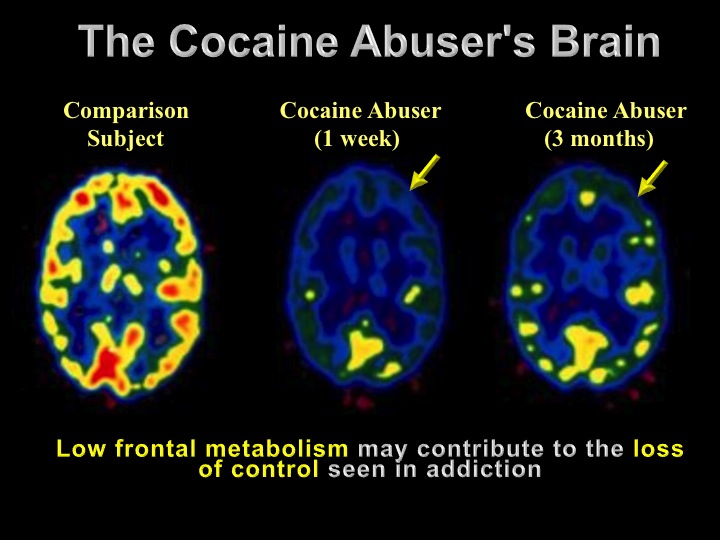
How does cocaine affect the brain?Through the use of sophisticated technology, scientists can actually see the dynamic changes that occur in the brain as an individual takes cocaine. They can observe the different brain changes that occur as a person experiences the "rush," the
"high," and finally the craving of cocaine. They can also identify parts of the brain that become active when a cocaine addict sees or hears environmental stimuli that trigger the craving for cocaine.
Researchers know that certain kinds of experiences, such as those involved in learning, can physically change brain structure and affect behaviour. Now, new research in rats shows that exposure to stimulant drugs such as cocaine can impair the ability of specific brain cells to change as a consequence of experience.
“The ability of experiences to alter brain structure is thought to be one of the primary mechanisms by which the past can influence behaviour and cognition,” says NIDA Director Dr. Nora D. Volkow. “However, when these alterations in brain structure are produced by drugs of abuse, they may lead to the development of compulsive patterns of drug-seeking behaviours that are the hallmark of addiction.”
The researchers conducted a series of experiments to examine how drugs of abuse and experience might interact to produce changes in brain structure. To accomplish this, they administered amphetamine, cocaine, or saline repeatedly for 20 days to individually housed rats. This pattern of drug administration was previously shown by these investigators to produce both behavioural changes in response to the drugs and structural changes in several brain regions. However, in the current study, the researchers went one step further. After the 20-day drug exposure, the rats were housed in a new environment for 3 to 3.5 months. Half of the drug- and saline-injected animals were placed in standard laboratory cages; the other animals in each group were housed in a complex environment.
The environment contained a variety of stimuli: multiple levels with ramps, bridges, a climbing chain, tunnels, and toys that were rearranged once a week to encourage continued exploration of the environment. At the end of 3 or 3.5 months, the rats’ brains were analyzed for changes in dendritic branching and spine density. Specifically, the researchers examined the spiny neurons in the nucleus accumbens and the pyramidal cells in the parietal cortex. These areas were shown in previous studies to be altered by experience and/or drugs of abuse. The nucleus accumbens is involved in motivation and reward, and the parietal cortex is important for sensory-motor function.
The researchers conducted a series of experiments to examine how drugs of abuse and experience might interact to produce changes in brain structure. To accomplish this, they administered amphetamine, cocaine, or saline repeatedly for 20 days to individually housed rats. This pattern of drug administration was previously shown by these investigators to produce both behavioural changes in response to the drugs and structural changes in several brain regions. However, in the current study, the researchers went one step further. After the 20-day drug exposure, the rats were housed in a new environment for 3 to 3.5 months. Half of the drug- and saline-injected animals were placed in standard laboratory cages; the other animals in each group were housed in a complex environment.
The environment contained a variety of stimuli: multiple levels with ramps, bridges, a climbing chain, tunnels, and toys that were rearranged once a week to encourage continued exploration of the environment. At the end of 3 or 3.5 months, the rats’ brains were analyzed for changes in dendritic branching and spine density. Specifically, the researchers examined the spiny neurons in the nucleus accumbens and the pyramidal cells in the parietal cortex. These areas were shown in previous studies to be altered by experience and/or drugs of abuse. The nucleus accumbens is involved in motivation and reward, and the parietal cortex is important for sensory-motor function.
Remarkably, animals that had been given amphetamine and then placed in the complex environment did not show the same environmental-induced structural changes in the nucleus accumbens and parietal cortex as did saline-treated animals in the complex environment. The results for those animals treated with cocaine were similar, in that prior treatment with cocaine blocked the environment-induced changes in the medium spiny neurons of the nucleus accumbens (the only region examined).
“The findings from this study indicate that at least some of the cognitive and behavioural advantages that accrue with experience may be diminished by prior exposure to psychostimulant drugs,” says Dr. Kolb.
“This impairment of the ability of specific brain circuits to change in response to experiences may help explain some of the behavioural and cognitive deficits seen in people who are addicted to drugs. More research is warranted to determine whether certain experiences, such as exposure to complex or rewarding environments, can alter the ability of drugs to induce structural changes in the brain. If exposure to psychostimulant drugs can alter the effects of subsequent experience, experience may be able to influence the later effects of drugs. It may even be possible for certain experiences to counteract the effects of psychostimulant drugs.”
source
“This impairment of the ability of specific brain circuits to change in response to experiences may help explain some of the behavioural and cognitive deficits seen in people who are addicted to drugs. More research is warranted to determine whether certain experiences, such as exposure to complex or rewarding environments, can alter the ability of drugs to induce structural changes in the brain. If exposure to psychostimulant drugs can alter the effects of subsequent experience, experience may be able to influence the later effects of drugs. It may even be possible for certain experiences to counteract the effects of psychostimulant drugs.”
source
No comments:
Post a Comment